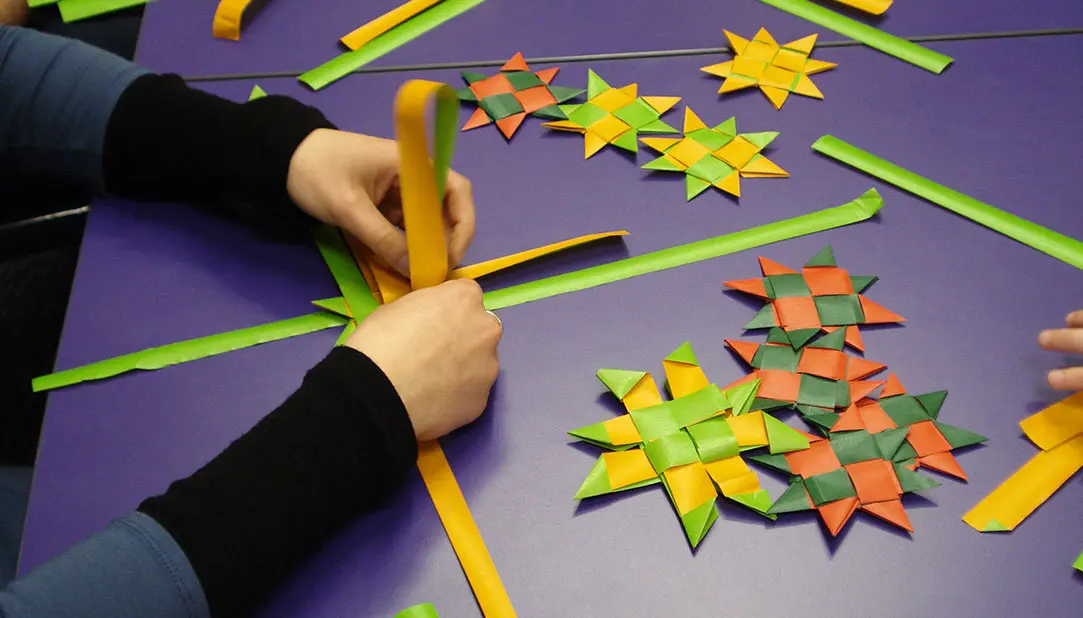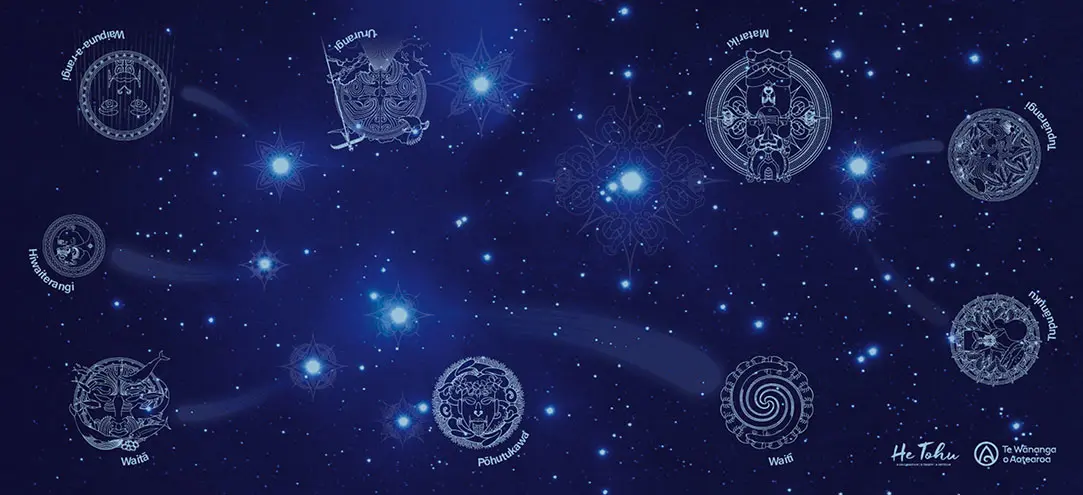Mānawatia a Matariki — Happy Māori New Year!
Discover some great resources to support teaching and learning about Matariki and ideas for celebrating the beginning of the Māori New Year in your school.
Mānawa maiea te putanga o Matariki.
Mānawa maiea te ariki o te rangi.
Mānawa maiea te Mātahi o te tau.
Celebrate the rising of Matariki.
Celebrate the rising of the lord of the sky.
Celebrate the rising of the New Year.
This Hōngongoi (July), people all over Aotearoa New Zealand will be taking part in traditions and festivities as Matariki rises to herald in Te Mātahi o te Tau, the Māori New Year.
This year, we acknowledge Matariki with a public holiday on 14 July 2023. Here's some information about how you can celebrate Matariki in your school and where to find resources to support teaching and learning.

Image credit: Matariki star weaving at Hornby. Christchurch City Libraries on Flickr. Some rights reserved: CC BY-NC-ND 2.0. Image cropped.
Ngā whetu o Matariki (the Matariki stars)
There are nine stars in te kāhuia o Matariki (the cluster of Matariki), although some iwi have names for seven of them. There are different pūrākau (stories) and names for the Matariki stars for different iwi around the motu (country).
Some consider the full name for the cluster to be Ngā Mata o te Ariki Tāwhirimātea (The Eyes of the God Tāwhirimātea). This comes from the pūrākau about Tāwhirimātea who, enraged by the separation of his parents Papatūānuku and Ranginui, clawed out his eyes and tossed them into the sky where they landed on the chest of his father.
Many Māori believe that Matariki is the central whetū (star) in the cluster — she is the whaea (mother) and is surrounded by her children. Their names, gender, and the elements or roles associated with them have similarities and variations for different iwi.
Here are a couple of examples:
Matariki and the six sisters — story by Ngāti Toa Rangatira (YouTube video, 6:31)
Matariki Te Whetū o te Tau | Dr Rangi Matamua and Living by the Stars and CORE Education (YouTube video, 1:21:49) — watch from 22:28 to hear about the stars, although I highly recommend the whole seminar.
The Matariki cluster is not the only whetū that marks the new year. For some iwi, Puanga (Rigel), Rehua (Antares) or Atutahi (Canopus) at certain positions can be signifiers of one year ending and a new one beginning. Rereata Makiha explains the importance of Puanga for Ngāpuhi in this Te Karere interview (YouTube video, 3:46).
The Matariki stars across the world
Matariki is the name given to this cluster for many islands right across the Pacific (Marshall Islands, Marquesas and New Caledonia to name a few).
Others have very similar names. For example, in Samoa, the cluster is known as Matali’i, and in Tokelau it is Mataliki. Stars were and are an important part of navigation for Pacific voyagers, and the Matariki cluster was used too like so many of the stars we see above us at night. In Hawaiian tradition, the Huhui-a-Makali‘i (the cluster of Makali‘i) was named after the navigator, Makali‘i, who used these stars as a guide to the easternmost island of Hawaii. Like us, they celebrate Makahiki, the Hawaiian new year, when Makali‘i rises.
The Matariki star cluster has many names around the world and has significance in many cultures. It is most commonly known as the Pleiades or the Seven Sisters, which comes from the Greek myth about the seven daughters of Atlas and Pleione who were turned into a flock of doves and cast into the sky.
In Japan, the stars are called Subaru which means ‘unite’ and in China, they are known as the blossom or flower stars. The Vikings called them Freya’s hens or chicks and the ancient Egyptians associated them with the goddess Neit/Neith. There are cultures across the Americas that, like us, use the position of this star cluster to signify a seasonal change and an important time for food, such as for the Navajo people who see it as a time for planting seeds and call it Dilyéhé.
Observing Matariki
Matariki is a time to reflect on the past and those who have passed on, to celebrate the present with kai and time with our whānau and communities, and to look ahead and plan for the future.
In his excellent seminar, Matariki Te Whetū o te Tau (YouTube video, 1:21:49), Dr Rangi Matamua also discusses the values underpinning Matariki by saying:
It’s about sharing and collectivity, coming together. It’s about the environment and giving back to the environment and being thankful … it is about aroha and manaakitanga and kai and whanaungatanga, and all of those good things that make people who they are. The best things that make us who we are. (At 1:16:56 in the video.)
Principles and values
Te Kāhui o Matariki Public Holiday Bill outlines the three major principles and 12 key values of Matariki, which could be aligned to your school's values and the key competencies of The New Zealand Curriculum.
The three major principles that guide Matariki are:
remembrance — honouring those who have died since the last rising of Matariki
celebrating the present — gathering together with family and friends
looking to the future — looking forward to the promise of a new year.
Matariki is also underpinned by key values, most significantly:
aroha — love and respect for one another
whakamaharatanga — remembrance
kotahitanga — unity
manaakitanga — caring
tohatoha — sharing
mana taiao — environmental awareness
hākari — feasting
wānanga — discussion
noho tahi — coming together
atawhaitanga — kindness
whakanui — celebrations
tuakiritanga — identity.
Te Kāhui o Matariki Public Holiday Bill
Here are some ideas for how you can help ākonga (students) learn about Matariki in your classroom.
Learn and share Matariki traditions
Learn about the stars and create a star map of how to find the Matariki cluster in the sky.
Ask your students to share their Matariki traditions, their whakapapa or what they are thankful for with the class.
Set goals or resolutions for the new year ahead.
Learn the Matariki pūrākau for your local rohe, and create a play in small groups or draw illustrations of parts of the story.
Spend some time winding down with a mindfulness activity like meditation or yoga.
Do some craft activities, learn waiata
Weave Matariki whetū — you can use harakeke, ribbon or even upcycle an old magazine. Here are some instructions.
Make lanterns and write wishes to Hiwaiterangi on them. Hiwaiterangi is one of the stars according to some pūrākau, and making wishes to her is part of Matariki tradition for some iwi.
Make and fly pākau (kites).
Teach your students the Matariki waiata — ‘Ngā Tamariki o Matariki’ — or another waiata to help them develop their skills in te reo Māori.
Resources for Matariki
Here are some resources you might find handy.
Matariki in Topic Explorer
Our Matariki topic includes a variety of hand-picked resources that explore all aspects of Matariki, including the stars, pūrākau, traditions and more.
You may also find these topics useful:
Matariki in Many Answers
Check out our Many Answers entries about Matariki and related topics, which include links to a number of quality websites and other useful resources that have been carefully selected by our librarians.
Other Matariki resources
Te Wānanga o Aotearoa has created this fantastic Matariki handbook to help guide you through your Matariki celebration, as well as other resources such as posters and colouring activities that are all free to download.
Te Papa Tongarewa also has a huge number of excellent supporting resources and information about Matariki.
Also, do check out the Matariki website for more information and resources, and a list of events happening around Aotearoa New Zealand.
Matariki events at the National Library
He Tohu at the National Library in Te Whanganui-a-Tara (Wellington) is holding a series of free Matariki events for tamariki and whānau during the school holidays.
Using a mixture of storytelling and interactive learning, explore how Matariki connects us to people, to whānau and to the rhythms and seasons of the natural world.

The Matariki map used in the learning programme, created in partnership with Te Wānanga o Aotearoa.
So let’s celebrate
Matariki is a time to come together and celebrate, acknowledge the past, and look ahead to what the new year will bring. It's also a great time to celebrate Māori culture and to learn and share Māori traditions, customs and stories.
Enjoy celebrating Matariki with your students this year!
This blog post
This blog post was first published in 2022. We've since updated and republished it with some wording changes including new He Tohu Matariki events.
Kia ora and thank you for your question! The maramataka (Māori calendar) is key when thinking about important times for planting and harvesting. The maramataka is an interconnected calendar system that follows the repeating cycles of the moon and the environment (including the position of whetū like the Matariki cluster). Good days for planting can be guided by the maramataka when the moon is in the right phase during the right season, but this varies depending on the rohe you live in. There is no one universal maramataka, there are many different ones used by different iwi, hapū and whānau around Aotearoa. I recommend watching the series Living by the Stars Whakamoe Tau by Dr Rangi Matamua (Tūhoe) as a good starting place for learning more about this, as well as his book Matariki: The star of the year to find out more about Matariki. Ngā mihi nui!